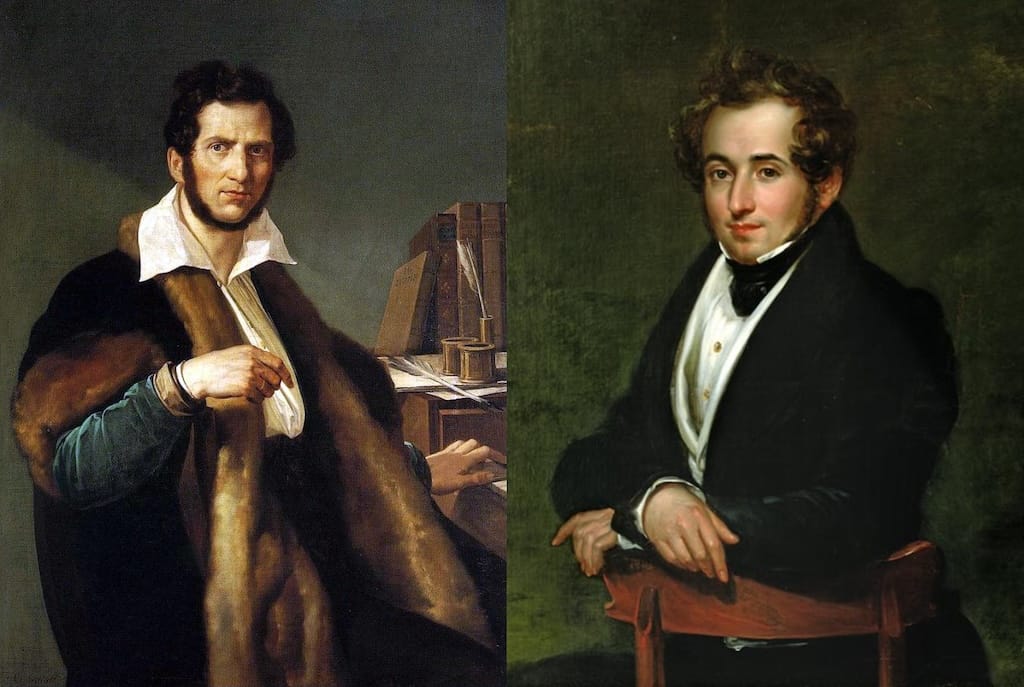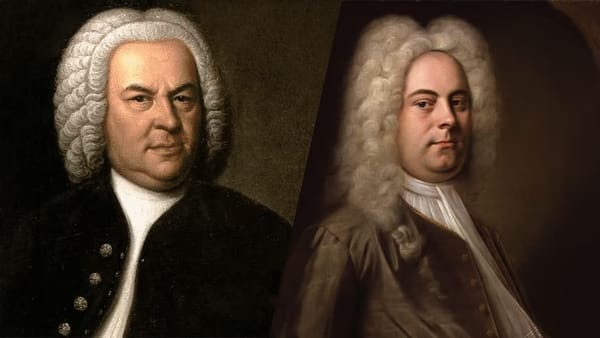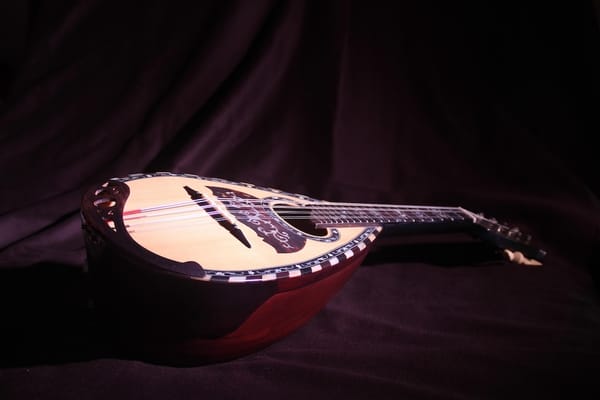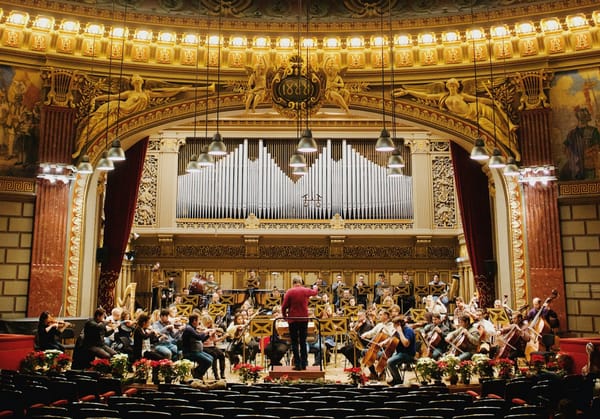The Lyrical Masters: How Bellini and Donizetti Defined Italian Opera
Bellini and Donizetti, the twin pillars of Italian bel canto, transformed opera into an art of lyrical beauty and emotional truth. Their timeless melodies, poetic drama, and expressive voices shaped the golden age of Italian music.

Few artistic rivalries have left as lasting an impression on the world of opera as that between Vincenzo Bellini and Gaetano Donizetti, two titans of early nineteenth-century Italy whose music defined what we now think of as bel canto— literally, “beautiful singing.” Their operas, filled with soaring melodies, expressive vocal writing, and dramatic intensity, set the stage for Verdi’s later grandeur and shaped the evolution of Italian opera for generations to come. While Bellini’s art was one of long, languid melody and tragic poetry, Donizetti’s was one of theatrical energy and emotional dynamism. Together, they captured the essence of human passion in sound, making the voice the supreme vessel of expression.
The World of Bel Canto
To understand Bellini and Donizetti, one must first understand the world they inherited. The early 1800s were a golden age for Italian opera. Rossini had already conquered Europe with his dazzling vocal fireworks and rhythmic brilliance, setting the standard for operatic composition. But as audiences’ tastes evolved, the appetite for pure virtuosity gave way to a hunger for greater emotional truth. The bel canto style, while demanding supreme vocal technique, was not merely about ornamentation; it was about the seamless fusion of melody, character, and feeling.
Bellini and Donizetti emerged as leading voices of this new sensibility. Both men were born in the first decade of the nineteenth century — Bellini in Catania, Sicily, in 1801, and Donizetti in Bergamo, northern Italy, in 1797. They belonged to a generation that saw opera as not only entertainment but a reflection of national identity, sentiment, and poetry. Their works took the elegant architecture of Rossini’s operas and filled it with personal depth and lyric passion.
Bellini: The Poet of Melody
Bellini’s genius lay in his extraordinary gift for melodic line. His music seems to breathe like a human voice, long-bowed and languorous, carrying emotion through phrases that unfurl like sighs. His contemporaries spoke of the “melodie lunghe, lunghe” — the “long, long melodies” — that became his hallmark. In an age when Italian opera was defined by dazzling coloratura and sparkling ensembles, Bellini dared to slow time down, letting his melodies bloom with aching purity.
His best-known operas — La sonnambula (1831), Norma (1831), and I Puritani (1835) — are masterpieces of lyrical expression. Norma, in particular, stands as one of the pinnacles of bel canto. The title role, a Druid priestess torn between love and duty, requires not only immense technical control but also deep psychological insight. The aria “Casta diva” remains one of the most exquisite examples of Bellini’s melodic art — a prayer suspended in stillness, its beauty lying in restraint rather than in bravura.
Bellini’s music was profoundly shaped by his collaboration with the librettist Felice Romani, whose refined poetry matched the composer’s own sensitivity. Together they created operas of unusual cohesion, where word and tone seem inseparable. Bellini’s orchestration was often simple, even spare, but this was deliberate: he wanted nothing to distract from the emotional nuance of the voice. His harmonies, though not revolutionary, are perfectly judged to support the singer, allowing the melody to soar with clarity.
There is something deeply Romantic in Bellini’s art — not the turbulent Romanticism of storm and struggle, but one of yearning and melancholy. His characters are often dreamers, lovers, and tragic heroines caught between duty and desire. In La sonnambula, the sleepwalking Amina embodies innocence and vulnerability, while I Puritani’s Elvira, driven to madness by love, reflects the Romantic fascination with psychological extremity. Bellini’s music gives these figures a voice of purity and sincerity, untouched by irony.
His influence extended far beyond his brief life — he died in 1835, at just thirty-three. Chopin idolised him, adopting his long melodic lines as a model for his piano writing; Wagner admired his ability to “speak directly to the heart.” In Bellini’s art, we hear the soul of melody itself — intimate, ineffable, and deeply human.
Donizetti: The Dramatist of Emotion
If Bellini was the poet, Donizetti was the dramatist. His genius lay in his sense of theatre — in his ability to balance lyric beauty with emotional urgency. Over the course of his career, Donizetti wrote more than seventy operas, ranging from broad comedy (L’elisir d’amore, Don Pasquale) to searing tragedy (Lucia di Lammermoor, Anna Bolena, Roberto Devereux). His fluency was astonishing; at his peak, he could compose an opera in weeks, yet his best works reveal remarkable craft and feeling.
Where Bellini’s music suspends time, Donizetti’s drives it forward. His operas are built on momentum, on the push and pull of dramatic tension. He inherited Rossini’s rhythmic vitality but expanded it with a keener sense of character and situation. Donizetti’s orchestra plays a more active role than Bellini’s — punctuating emotion, colouring atmosphere, and heightening conflict.
One of his greatest achievements is Lucia di Lammermoor (1835), based on Walter Scott’s novel The Bride of Lammermoor. Its heroine, Lucia, is a fragile figure destroyed by love and family duty, culminating in the famous “mad scene,” a tour de force of coloratura that transforms insanity into music. Donizetti uses the voice not merely to decorate but to dramatise; the florid runs and trills become expressions of Lucia’s disintegrating mind. The eerie accompaniment of the glass harmonica — or flute, in modern performances — adds a haunting shimmer, turning madness into tragic beauty.
In his so-called “Tudor trilogy” (Anna Bolena, Maria Stuarda, and Roberto Devereux), Donizetti turned history into high drama. These operas reveal his mastery of pacing, his ability to fuse public spectacle with private emotion. Queens, lovers, and rivals are all portrayed with musical depth: the dignity of Anna Bolena’s final aria, the fiery confrontation between Mary Stuart and Elizabeth I, the fatal tenderness of Roberto Devereux’s farewell — all show Donizetti’s instinct for human truth within operatic form.
Yet Donizetti was not only a tragedian. His comic operas display a warmth and wit that balance his darker side. L’elisir d’amore (1832) is a perfect blend of charm and sentiment, its famous tenor aria “Una furtiva lagrima” expressing love’s vulnerability in a single, unforgettable phrase. Don Pasquale (1843), written later in his career, refines the comic tradition with elegance and insight, its characters drawn with affectionate realism rather than caricature.
Donizetti’s career also reveals a transitional spirit. His later works anticipate Verdi in their stronger orchestration and more continuous dramatic flow. Where Bellini seemed to belong to a world of idealised emotion, Donizetti pointed towards the realism and force of the mid-nineteenth century.
Two Masters, Two Visions
Bellini and Donizetti were often compared in their lifetimes — sometimes unfairly. Critics of the time saw Bellini as the noble lyricist and Donizetti as the prolific craftsman. Yet the truth is more nuanced. Bellini’s output may have been small, but each work is a distillation of his unique sensibility. Donizetti, by contrast, was more varied, capable of both the sublime and the light-hearted.
Their relationship was complex but largely respectful. Donizetti admired Bellini’s melodic genius, while Bellini, though occasionally wary of his rival’s success, recognised his theatrical flair. The two composers together defined the Italian operatic ideal of the 1830s: the marriage of vocal beauty and dramatic truth.
Their differences reflect two sides of Italian Romanticism. Bellini speaks to the inward world of feeling, of longing and contemplation; Donizetti, to the outward world of passion and action. Bellini’s art ends in silence — a sigh, a fading chord — while Donizetti’s burns with vitality until the final curtain.
Legacy and Influence
Both composers were central to the evolution of Italian opera, but their influence reached far beyond their lifetimes. When Bellini died in 1835, and Donizetti followed just thirteen years later, a new generation was already emerging. Giuseppe Verdi, born in 1813, would take up the mantle and carry Italian opera into a new dramatic age. Verdi absorbed Bellini’s gift for melody and Donizetti’s sense of theatre, transforming both into his own unmistakable voice.
In the later nineteenth and twentieth centuries, the bel canto tradition fell somewhat out of fashion as grand opera and verismo took centre stage. But in the mid-twentieth century, singers like Maria Callas, Joan Sutherland, and Beverly Sills revived Bellini and Donizetti’s works with renewed passion and technical mastery. Their performances reawakened audiences to the emotional and vocal richness of this repertoire. Today, operas such as Norma, Lucia di Lammermoor, and L’elisir d’amore are among the most frequently performed in the world.
The legacy of Bellini and Donizetti lies not only in their music but in their vision of what opera could be — an art of the human voice at its most expressive. In their hands, melody became drama, and drama became song. Their operas remind us that in the right hands, simplicity can be profound, and beauty can convey truth.





